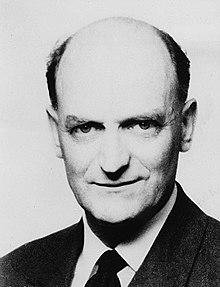William Phillips (economist)
| William Phillips | |
|---|---|
 |
|
| Born |
18 November 1914 Te Rehunga near Dannevirke |
| Died | 4 March 1975 (aged 60) Auckland |
| Nationality | New Zealand |
| Institution |
Australian National University University of Auckland |
| Field | Macroeconomics |
| School or tradition |
Neo-Keynesian economics |
| Alma mater | London School of Economics |
| Influences |
Irving Fisher John Maynard Keynes |
| Influenced |
Paul Samuelson Robert Solow Edmund Phelps |
| Contributions | Phillips curve |
Alban William Housego "A. W." "Bill" Phillips, MBE (18 November 1914 – 4 March 1975) was an influential New Zealand economist who spent most of his academic career as a professor of economics at the London School of Economics (LSE). His best-known contribution to economics is the Phillips curve, which he first described in 1958. He also designed and built the MONIAC hydraulic economics computer in 1949.
Phillips was born at Te Rehunga near Dannevirke, New Zealand, to Harold Housego Phillips, a dairy farmer, and his wife, Edith Webber, a schoolteacher and postmistress.
He left New Zealand before finishing school to work in Australia at a variety of jobs, including crocodile hunter and cinema manager. In 1937 Phillips headed to China, but had to escape to Russia when Japan invaded China. He travelled across Russia on the Trans-Siberian Railway and made his way to Britain in 1938, where he studied electrical engineering. At the outbreak of World War II, Phillips joined the Royal Air Force and was sent to Singapore. When Singapore fell, he escaped on the troopship Empire State, which came under attack before safely arriving in Java.
When Java, too, was overrun Phillips was captured by the Japanese, and spent three and a half years interned in a prisoner of war camp in the then Dutch East Indies (now Indonesia). During this period he learned Chinese from other prisoners, repaired and miniaturised a secret radio, and fashioned a secret water boiler for tea which he hooked into the camp lighting system. In 1946, he was made a Member of the Order of the British Empire (MBE) for his war service.
...
Wikipedia
